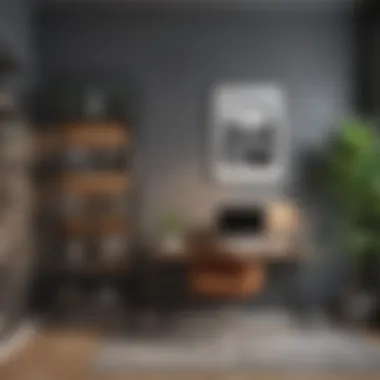Smart Design Tips for Your Small Home Office


Intro
In today's world, where the hustle of remote work is becoming the norm, creating an efficient small home office has moved from being a luxury to a necessity. Many might think a cramped corner in the living room or a small nook in the bedroom can't possibly serve as a productive workspace. However, with the right strategies, even the tiniest of spaces can be transformed into an inspiring and functional office that caters to both work needs and personal style.
As we delve into the essential elements of designing a small home office, this exploration will touch on trends, color choices, and the incorporation of personal touches. These aspects are crucial in ensuring that the home office radiates not just productivity, but also comfort and individuality.
Trending Styles
Creating a small office doesn't just involve functional elements; it also offers a chance to showcase style. Here we will explore two popular design trends that are particularly suitable for compact workspaces: Modern Minimalism and Cozy Rustic.
Modern Minimalism
This style is all about simplicity and functionality. The idea here is to keep only what is necessary, contributing to a clutter-free environment. Here's how you can implement modern minimalism in your home office:
- Furniture Selection: Choose desks with clean lines and open designs, like glass or light wood. Folding tables are also excellent choices, allowing you to maximize space when not in use.
- Storage Solutions: Opt for vertical storage, such as wall-mounted shelves, which help you utilize wall space effectively without adding bulk to the floor.
- Modifiers: Incorporate a few accessories that bring personality without overwhelming the space—think a single plant or a striking piece of art.
Cozy Rustic
On the flip side, the cozy rustic style evokes warmth and comfort, perfect for those working long hours at home. To achieve this:
- Natural Materials: Use wooden furniture and accents. Reclaimed wood is particularly stylish and sustainable.
- Textiles: Introduce rugs or curtains in warm hues or soft textures to soften the space—think cotton or wool blends.
- Decorative Touches: Include personal touches like family photos or souvenirs from travels to give the space character while maintaining that inviting atmosphere.
"Your workspace should be a visual representation of what motivates you and makes you comfortable."
Color Palettes
The colors you choose play a significant role in the ambiance of your home office. Below we break down two effective palettes: Calming Neutrals and Bold Accents.
Calming Neutrals
Soft, muted colors like beige, light grey, or soft white can help create a peaceful and focused environment. These colors often promote concentration and relaxation, making them perfect for a workspace.
- Wall Colors: A fresh coat of calming neutral can help open a small room visually.
- Furniture Tint: Light-colored furniture blends seamlessly with neutrals for a cohesive look.
Bold Accents
If you prefer something more vibrant, don’t shy away from bold accents. This could be in the form of a vibrant desk chair, colorful artwork, or even a feature wall painted in a striking color like teal or orange.
- Small Doses: Incorporate bold colors in ways that won't bombard the senses; a single bright accessory can make an impact without overwhelming the space.
- Balance: Always balance bold colors with neutral elements to keep the workspace grounded.
In the journey of crafting a spectacular home office, understanding and embracing trends, while tuning into personal preferences is key. As we move further into this guide, we'll explore additional elements like the importance of ergonomics, lighting, and how to inject your personality into the setup. So, let’s roll up our sleeves and get to it.
Understanding the Importance of a Small Home Office
Creating a small home office isn’t just a matter of convenience; it’s about embracing a lifestyle shift. In today's world, remote work has become more than a trend—it's a new reality. Designing a dedicated workspace at home can significantly influence both productivity and overall well-being.
One key aspect to consider is the boost in focus that having a designated space can provide. When you carve out an area tailored for work, it helps in mentally separating office hours from personal time. This separation is crucial, especially for housewives and homeowners who are balancing multiple roles. By affixing boundaries, productivity often spikes, and distractions diminish.
"A home office is more than just a corner; it's an environment that fosters inspiration and concentrates effort."
Furthermore, a well-designed small home office can enhance the aesthetics of your living space. It’s not merely about putting a desk and a chair in one room; it’s about harmonizing design with function. Imagine a corner that invites creativity, perhaps adorned with your favorite art pieces or calming colors. This thoughtful design can boost your mood, making work feel less like a chore and more like a joy.
A small home office should also reflect its user's personality. Whether you prefer a minimalist aesthetic or a more eclectic approach, incorporating personal touches can motivate and encourage better workflow. In many cases, even small changes such as the addition of vibrant plants or custom accessories can make a significant impact.
The importance of setting up a small home office extends to health considerations as well. Investing in ergonomic furniture not only plays a role in productivity but also promotes better posture and reduces strain during long working hours. Over time, this can prevent discomfort and contribute to long-term physical wellbeing.
Lastly, with the rise of remote work opportunities, creating a focused workspace has become a valuable asset in job performance. As more employers are recognizing remote or hybrid work models, a home office becomes essential for efficiently navigating projects and collaborations without the traditional office distractions. Therefore, integrating smart solutions for a small home office is not just beneficial, but quite essential in today’s working environment.
The Rise of Remote Work
Over the past few years, a defining shift in professional dynamics has taken hold—remote work is here to stay. Various forces, be it advances in technology or the global pandemic, have fueled this change. People who once commuted daily are now finding liberation in working from home, and with this transition, the need for effective small home office design has emerged as a critical priority.
Remote work offers both flexibility and autonomy, allowing individuals to structure their days according to personal peaks in productivity. Whether you’re a writer, a programmer, or managing business dealings, being able to avoid long commutes means extra time for work or personal interests. But with benefits come challenges. Without a dedicated workspace, blending personal life with work can lead to distractions and ultimately burnout.
Key benefits of remote work include:
- Improved flexibility in work schedules
- Elimination of daily commutes
- Greater equilibrium between personal and professional lives
To maximize the advantages of remote work, creating a designated workspace proves paramount. A small home office not only enhances productivity by reducing distractions but also establishes a routine. This structure encourages individuals to keep focus and manifest their best work.
Work-life Balance Considerations
As we delve deeper into the essence of a small home office, work-life balance is not just a buzzword; it’s both a necessity and a practice. It’s vital to create boundaries that separate work from personal time, especially when your office shares walls with your living space.
Having a dedicated office can encourage healthier working hours. When your workspace is defined, it becomes easier to signal to your brain that it’s time to switch on for work and similarly, when to switch off. This helps maintain productivity without compromising your home life.
Moreover, it’s beneficial to consider the psychological impacts of a well-designed workspace. A space that’s pleasing to the eye can aid in reducing stress and enhancing mental clarity. Moreover, integrating comforting yet functional features can create a more inviting work environment. This could be something as simple as a soft chair or a window view that opens up to nature.
To foster work-life balance, consider the following tips:
- Set specific hours for work to avoid blurring the lines between personal and professional time
- Create routines for both start and end of the workday
- Use office space to focus, while reserving other areas of the home for relaxation and leisure


In summary, understanding the importance of a small home office is about more than just having a place to work. It’s about crafting a setting that aligns with modern work habits while promoting a healthy lifestyle. By appreciating and implementing these strategies, remote work can lead to a fulfilling balance of productivity and personal peace.
Assessing Available Space
When embarking on the journey of designing a small home office, the first crucial step is assessing the available space. This process goes beyond simply measuring the length and width of a room. Instead, it involves a thorough examination of various elements that can impact both functionality and aesthetics in your workspace.
Understanding your space helps you avoid missteps that could quickly turn into frustrations. It allows for a tailored approach that aligns with not only your personal style but also the requirements of your work. Considerations might include, but are not limited to, the overall layout of your home, ambient light sources, and noise levels. In the following sections, we will explore how to identify potential areas and the importance of precise measurements in securing a productive work environment.
Identifying Potential Areas
Identifying potential areas for your small home office requires a bit of creativity and practical consideration. Some houses offer nooks, corners, or smaller rooms that can easily evolve into a workspace with the right design strategies. For instance, the space under the stairs can be transformed into a cozy workstation by incorporating smart storage solutions and compact furniture.
Additionally, think about the areas that might not be used so effectively right now. Hallways or rooms that don’t see much traffic can become valuable work zones. If you have a spare bedroom, it could be another canvas to work on. Do keep in mind other mundane spots like the dining room table if you are aiming for flexibility and interchangeability.
The key here is to keep an open mind and explore every nook and cranny of your home. As space constraints vary greatly, what works for one household may not work for another. Before making a decision, consider factors like daylight exposure and accessibility to outlets to suit your tech devices.
Measuring Your Space
Once you’ve identified potential areas, the next logical step is to accurately measure your space. This task might seem straightforward, but it often carries more weight than one might think. Having precise measurements allows you to visualize how furniture and equipment will fit, preventing any future headaches from overly large items or cramped layouts.
Start by measuring the dimensions of the room, including its height. Make note of windows, doors, and any built-in furniture. Here’s a brief rundown on what to consider during your measurements:
- Width and Length: The total area can significantly dictate what type of furniture will fit.
- Height: Sometimes, vertical storage or wall-mounted solutions can save space.
- Obstacles: Identify any obstructions, like radiators or vents, that may influence your layout options.
If you have measuring tape, that’s great! But if you happen to have a smartphone, many applications these days can assist with measurements and even help visualize different layouts.
Ultimately, compiling these measurements leads to a more structured layout plan. So, take the time to do this right to ensure a neat arrangement of your gear.
"Proper space assessment fuels better design decisions, paving the way for a workspace that both inspires and functions seamlessly."
In summary, the process of assessing available space is about looking at your home through a different lens. It demands consideration, precision, and sometimes a dash of creativity to ensure you establish a workspace that not only meets practical needs but also aligns with your aesthetic vision.
Design Principles for Small Offices
Design principles form the backbone of any effective workspace, especially in small home offices. When space is limited, every inch counts. Implementing thoughtful design principles can enhance both functionality and aesthetics in a small area. Well-considered design influences productivity, promotes creativity, and can even alleviate stress. The principles at play affect how a space feels and operates, making it essential to prioritize them in a small home office setup.
Open versus Closed Layouts
Choosing between an open or closed layout can be a game-changer for a small home office. An open layout encourages collaboration and a sense of freedom. For instance, if you're working in a space where you might have visitors, an open design can facilitate easier conversations. However, it's important to bear in mind that too much openness can invite distractions. Finding a balance is key.
On the other hand, a closed layout promotes focus and minimizes interruptions. For homeowners with children or pets, a small closed-off area can feel like a sanctuary. Having the door shut can provide that much-needed quiet time and help delineate work from home life, which is often blurred in a remote setup.
Here are some considerations:
- Open Layout Benefits:
- Closed Layout Advantages:
- Encourages communication.
- Feels more spacious.
- Easier to shift furniture around for new arrangements.
- Better concentration, especially in a busy household.
- Clear separation from home responsibilities.
- Ideal for tasks requiring intense focus or privacy.
Ultimately, the choice hinges on individual needs and the environment in which one works.
Maximizing Natural Light
Natural light does wonders for any workspace, but especially in small offices. It can make a tight area feel more expansive and inviting. The psychological benefits are impressive, too; studies have shown that exposure to daylight can help improve mood and increase productivity. In a small office, planning to maximize this resource is crucial.
Some effective strategies for capturing natural light include:
- Positioning your desk near windows to soak in as much sunlight as possible. If you can, align it with the view outside, providing a pleasant distraction during breaks.
- Using sheer curtains to allow light in without compromising privacy.
- Avoiding heavy furniture that might block sunlight.
- Adding mirrors to reflect light throughout the space. This tricks the eye into thinking the area is larger and brighter than it actually is.
"Harnessing the power of natural light transforms not just how we see our work but also how we feel about it."
Incorporating these elements into the design makes a small office feel more open, energetic, and conducive to work tasks.
In sum, proper design principles harmonize style with functionality. In an era of remote work, creating an environment that caters to both productivity and comfort is no longer a luxury but a necessity.
Selecting Suitable Furniture
Choosing the right furniture for a small home office can feel daunting, but it’s a vital component of creating a functional workspace. The furniture you select can either enhance your productivity or hinder it, shaping your daily working experience.
In a limited space, it’s crucial to prioritize versatility and space efficiency. Furniture should not only be visually appealing but also cater to your specific work habits and routines. Consider how each piece will contribute to your workflow and overall comfort, as these factors can significantly impact your performance over time.
Compact Desks and Workstations
Compact desks are a game changer when it comes to small office design. They utilize limited square footage effectively, allowing for ample surface area without overwhelming the room. Whether it’s a wall-mounted fold-down desk or a sleek corner unit, compact designs guarantee you don’t sacrifice function for space.
- Space-saving options: Look for desks that can serve multiple purposes, such as one that includes shelves or drawers.
- Mobility: Consider mobile desks with wheels. They can be moved out of the way when not in use, keeping the space open and airy.
Moreover, the choice of material isn’t just about aesthetics. For instance, glass tops can create an illusion of more space, making a room feel less cramped.
"Selecting a desk is not just about what looks good; it’s about what serves you best in your daily tasks."


Ergonomic Seating Solutions
Seating is another key element that can affect your productivity and health. Ergonomic chairs are designed to support your body and promote good posture, which is particularly important when working long hours. A well-chosen chair can reduce the risk of back pain and discomfort, making your work experience much more enjoyable.
- Adjustability: Look for chairs that allow you to adjust the height and lumbar support to fit your body perfectly.
- Material: Breathable fabrics or mesh will keep you comfortable during lengthy projects.
Investing in a high-quality ergonomic chair might seem pricey initially, but in the long run, it pays off through improved comfort and decreased health issues.
Incorporating Multi-functional Furniture
When space is at a premium, multi-functional furniture can be your best friend. These pieces serve more than one purpose, allowing you to make the most of your limited area. For instance, a desk that doubles as a bookshelf not only provides workspace but also storage for your books and files, adding to the aesthetic of the room as well.
- Convertible furniture: Consider a sofa bed if your office needs to transition to a guest space occasionally.
- Storage features: Desks with built-in cabinets or shelves reduce clutter while keeping everything you need within reach.
Color Schemes and Decor
Color schemes and decor play a significant role in establishing the vibe of your small home office. A well-thought-out color palette not only influences how you feel when you step into the room, but it can also have a profound effect on your productivity. When choosing colors, consider how they will blend with your existing space, the amount of natural light you receive, and the overall emotion you want your workspace to evoke. With the right colors and decor, your small office can transform into a haven of focus and creativity.
Choosing Colors for Focus and Calm
When selecting colors, it’s crucial to strike the right balance between energy and calm. Cool colors, like blues and greens, can create a serene atmosphere conducive to concentration. They’re known to reduce anxiety and promote tranquility, making them perfect for a place filled with tasks and responsibilities. On the other hand, warm colors, such as yellows and oranges, can ignite enthusiasm and inspire productivity.
Keep in mind the size and lighting of the room. Dark colors may work wonders in spacious rooms but can make confined spaces feel even smaller and more cramped. Consider lighter hues that reflect light and create a more airy feel.
Many experts recommend the use of an accent wall—a bold color on one wall to add depth and interest without overwhelming the space. Another idea is to blend soft neutrals with pops of color in accessories, furniture, and art. This approach keeps the workspace inviting while ensuring that focus remains on the tasks at hand.
"The right color can speak volumes about your intentions and goals within your workspace."
Tips to Consider:
- Match your color scheme with your personal style to create harmony.
- Utilize color psychology to understand how different colors can impact your mood.
- Experiment with paint swatches on the wall before making your final decision.
Utilizing Wall Art and Accessories
The decor of your home office often gets overlooked, yet it can make a world of difference. Wall art and accessories have the remarkable ability to personalize your workspace, reflect your personality, and even inspire you. A blank wall can feel cold and uninspiring, but a carefully chosen piece of art can breathe life into the room.
When selecting wall art, aim for items that resonate with your work or hobbies. Perhaps a motivational print that uplifts your spirits or a tranquil landscape that soothes your mind. Make sure the pieces are in harmony with your color scheme to evoke a seamless experience.
Additionally, accessories such as shelves can serve dual purposes—display your curated collection of books and plants, or even those quirky little trinkets that tell stories about you or your career. Functional decor, like a stylish clock or a pinboard, can be both practical and beautiful at the same time.
Here are some suggestions for decor elements:
- Framed prints: Choose artwork that aligns with your taste and inspires action.
- Plants: Greenery improves air quality and adds color, bringing a slice of nature inside.
- Unique Lighting: Task lighting can double as decor—think lamps with chic designs to brighten up your workspace.
Emphasizing your personality through decor not only enhances the aesthetics of your workstation but also serves as a constant reminder of motivation and creativity.
Incorporating Technology
In this modern age, technology isn't just a luxury; it's a necessity, especially when it comes to creating a small home office. The right tech can significantly enhance both functionality and productivity. From communication tools to productivity software, integrating technology thoughtfully can transform a cramped workspace into a powerhouse of efficiency.
Choosing the Right Equipment
Selecting the right equipment is crucial for a small home office. Opting for compact gadgets that deliver high performance allows one to maximize space without sacrificing productivity. Key considerations include:
- All-in-One Computers: Instead of bulky setups with a monitor, tower, and peripherals, an all-in-one computer like the Apple iMac or HP Envy saves space and can be aesthetically pleasing.
- Laptops: A good laptop, such as the Dell XPS or Lenovo ThinkPad, offers portability, which is helpful if you need to shift your workspace from one corner of the room to another.
- Ergonomic Tools: Equip your office with an ergonomic keyboard and mouse to prevent strain during long working hours.
- Voice Assistants: Devices like Amazon Echo or Google Nest can schedule tasks and manage calls hands-free, giving you more time to focus on work.
With the right equipment, not only do you make the most of your available space, but you also create an environment that feels tailored to your needs.
Managing Cables and Clutter
Cables can quickly turn a neatly-organized desk into a jumbled mess, creating distractions and an unappealing workspace. Managing these cables is important for both aesthetics and functionality. Here are some effective strategies:
- Use Cable Management Tools: Velcro ties, sleeves, and clips can keep cords together and out of sight, making your desk look tidy.
- Cable Boxes: These boxes can conceal power strips and excess cable length, keeping surfaces clear.
- Under-Desk Solutions: Consider using adhesive cable trays that attach under your desk, allowing you to run cords efficiently without them being visible.
- Wireless Devices: Where possible, go wireless. Bluetooth headsets and wireless printers can drastically reduce the number of cables in your workspace.
By employing a few clever tricks, you can maintain order in your workspace, fostering an environment that is both functional and calm.
Tip: Regularly declutter your technological items. Whether it’s deleting apps you no longer use or ensuring you don’t have unnecessary hardware around, less is often more.
Smart Storage Solutions
When it comes to designing a small home office, storage usually feels like a never-ending challenge. Applying smart storage solutions is not just about keeping the space tidy; it significantly impacts your productivity and focus. Any clutter can be incredibly distracting, especially in a space that’s meant for concentration and creativity. By managing your belongings well, you can create an environment that fosters both efficiency and relaxation.
Utilizing Vertical Space
Vertical space is the unsung hero of small offices. Every home office has some walls, and these surfaces provide endless possibilities for storage. Think about stacking shelves, wall-mounted file holders, or pegboards for office supplies. By taking advantage of the vertical area, you can free up precious desk space for more critical tasks.
- Wall shelves: These are ideal for books, plants, or even decorative items that inspire you daily.
- Hanging organizers: Use them for essential documents or supplies that you frequently need at your fingertips.
- Over-the-door storage: It’s clever to repurpose this often-overlooked space for hanging baskets or peg hooks for items like your headphones or keys.
"Maximizing vertical space not only declutters your desk but can also add a unique aesthetic element to your home office."
A well-arranged vertical storage system can create a streamlined look while making everything easily accessible. Plus, it draws the eye upwards, giving an illusion of a larger space, which is always a bonus.


Incorporating Hidden Storage
Hidden storage is the magician of the home office world. It’s all about finding clever ways to conceal your belongings so that they don’t overwhelm your workspace. This can totally transform not just the look of your office but also how you feel when you walk into it.
Consider integrating furniture that offers built-in storage, like:
- Desks with drawers: A desk that has integrated drawers allows you to tuck away your supplies and keeps the workspace clean.
- Ottomans or benches: These can serve double duty as seating and a storage unit for files or miscellaneous items that would otherwise clutter your floor.
- Cabinets with doors: Opt for stylish cabinets which can hide away anything from paperwork to printer supplies, making your office look more organized.
Ensuring that everything has its place helps to maintain an inviting atmosphere in your home office. Hidden storage can be clever and stylish, allowing you to combine function with aesthetics seamlessly.
In summary, integrating smart storage solutions like utilizing vertical space and incorporating hidden storage not only provides practical benefits but also enhances the overall feel of your small home office. These strategies create an environment that is both productive and peaceful, allowing for an inspiring work atmosphere.
Creating an Inspiring Atmosphere
Creating an inspiring atmosphere within your home office can make all the difference in how you feel during your workday. It’s not just about having a desk and a chair; it’s about cultivating an environment that fosters creativity, productivity, and personal satisfaction. An inspiring workspace can improve focus and reduce stress, ultimately leading to higher quality work.
When designing your office, consider elements that resonate with you personally and can boost your mood. Colors, textures, and decorations should reflect your taste and personal values. An inviting and aesthetically pleasing environment encourages a positive state of mind, which is often reflected in one’s work performance.
Incorporating Plants and Nature
One effective strategy in enhancing your workspace is by incorporating plants and elements of nature. Biophilia, the human tendency to connect with nature, can profoundly impact your mood and productivity levels. Adding a couple of potted plants or a small indoor garden can break the monotony of a typical office setting.
The benefits are manifold:
- Air Quality Improvement: Plants purify the air by absorbing toxins, which can enhance your overall well-being.
- Enhanced Aesthetics: A touch of greenery can make your space feel more vibrant and alive.
- Stress Reduction: Research indicates that being around plants can decrease stress and increase happiness.
Some easy-to-care-for options include succulents, snake plants, and pothos. These varieties bring life to your desk without demanding too much attention.
"A touch of greenery transforms any space, making it feel fresh and inviting."
Personalizing Your Space
Personalization is key when designing your small home office. This is your sanctuary, and it should reflect who you are. Consider adding personal touches that make it feel uniquely yours.
There’s a plethora of ways to infuse personality into your office:
- Artwork: Hang pieces that inspire you—whether they are paintings, photographs, or motivational quotes.
- Decorative Objects: Incorporate items that resonate with your journey, like souvenirs from travels or gifts from loved ones.
- Functional Items: Personalize your desk with customized stationery or tools that not only serve a purpose but also express your character.
Remember, the goal isn’t just to make the space look good; it’s about creating a comforting locale where you can immerse yourself in your work. Every piece you add should be a reflection of you, fostering a sense of pride and tranquility while you grind away at your tasks.
By creating an engaging and personalized atmosphere, your home office will not only be a functional workspace, but it will also be a true extension of yourself.
Establishing Work Zones
Creating distinct work zones within a small home office is an effective strategy for enhancing productivity and maintaining organization. The very essence of establishing these zones lies in recognizing that not all tasks are created equal. By delineating areas for specific functions, you can foster a tailored environment that caters to your workflow needs. Whether you're brainstorming ideas, engaging in virtual meetings, or diving deep into solitary tasks, having a structured approach allows for seamless transitions between activities.
Defining Separate Areas for Tasks
To begin with, you want to carve out spaces that clearly define what you’ll do in each zone. It's not just about setting things up randomly; think of it as creating mini-offices within your main workspace. For instance, a small corner table could be used solely for creative work—keeping art supplies or stationery handy. Likewise, having a separate section for administrative tasks with a laptop and essential paperwork can greatly help in keeping distractions at bay.
Consider how one might set boundaries using furniture placement. A bookshelf can serve as a subtle divider, creating a sense of separation without isolating oneself completely. It aids not only in organizing but also in providing a visual cue on where focus should be directed. Additionally, the use of rugs can also help signify different areas. This can effectively signal to your mind that it’s time to switch gears.
Boosting Productivity with Zoning
When you create specific zones for distinct tasks, you’re essentially setting yourself up for greater efficiency. Having a designated area for each type of work can boost your productivity significantly—this is because your brain quickly learns to associate each space with its corresponding activity.
For example, if every time you sit in the reading nook, you read or brainstorm, your mind starts to link that space with such activities. The same principle applies if you have a workstation for video calls; over time, that corner becomes the ‘go-to’ space for discussions and collaboration.
Moreover, consider the psychological benefits. When you step into an area meant specifically for focus and creativity, it can trigger a positive mindset conducive for work.
"Establishing work zones gives a sense of order, helping you to concentrate on tasks without the noise of multitasking."
Of course, it’s worth noting that not every home office layout allows for rigid separations—adaptability is key. You may find that rolling carts or movable screens are helpful aids in managing your space according to daily routines. At the end of the day, being flexible with your zones keeps the energy flowing and avoids stagnation, which is particularly beneficial when working from home.
Achieving balance in your home office through these work zones can lead to an efficient and enjoyable workspace where productivity flourishes. As you adapt to setting up distinct work areas, always remember to revisit and modify as your tasks and priorities change.
Maintaining Flexibility in Design
In designing a small home office, maintaining flexibility holds significant value. Home environments are dynamic, often transforming over time as needs evolve and personal situations change. A design that can adapt is not just about aesthetics; it’s a substantial strategy to enhance productivity, comfort, and overall satisfaction in your workspace.
Emphasizing flexibility involves selecting furniture and layouts that are not fixed but can be rearranged or repurposed. For instance, opting for modular furniture can allow you to change your office layout easily, catering to urgent tasks, spontaneous projects, or even different moods.
Adapting to Changing Needs
As life circumstances shift—be it family changes, new hobbies, or evolving work responsibilities—the demands placed on your office may shift as well. The main priority should be to create an adaptable space. This means considering multi-purpose items, such as a desk that can double as a craft table or a sofa that can serve as guest seating at times.
- Multi-Functional Furniture: Look for pieces that serve dual purposes. For example, an ottoman with storage can act both as a footrest and a place to stow away supplies.
- Adjustable Desks: These allow you to switch between sitting and standing, accommodating varying preferences and promoting a healthy work posture.
- Flexible Lighting: Use lamps with adjustable brightness that can help set the mood, whether you are in a focus zone or winding down at the end of the day.
Adapting your design also means being open to regularly assessing your needs. This can involve maintaining an eye on how often you use specific areas and changing them up if certain spots don’t offer the functionality you thought they would.
Revisiting Design Choices
Regularly revisiting your design choices enables you to align your workspace with current demands and preferences, which can enhance productivity. Nobody wants a stale environment, and keeping things fresh can invigorate your routine.
- Evaluate Your Workflow: Take a step back and critically examine how you work. Are you tripping over a poor layout? Is it time to hang different art on the walls or swap out a chair that no longer provides support?
- Change is Key: Just like the seasons, your workspace can benefit from seasonal changes. Introducing new colors or temporarily rearranging furniture can help maintain excitement and encourage new patterns of thought.
- Stay Informed About Trends: While it isn’t necessary to jump on trends, understanding popular designs can influence your choices and result in a more contemporary feel. New innovations in furniture design might offer solutions you hadn’t considered before.
"Adaptability is a crucial element in any design; it allows space to grow with its user."















